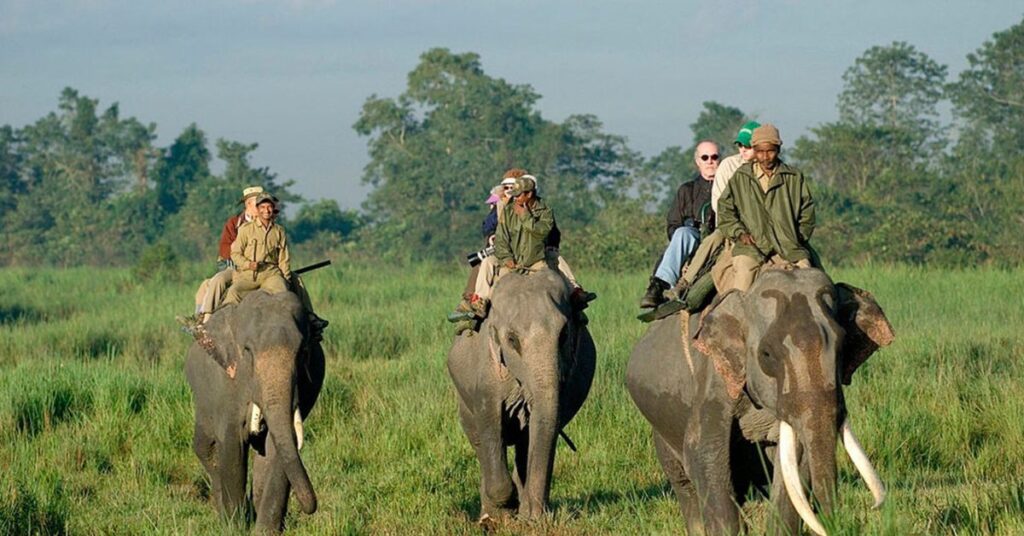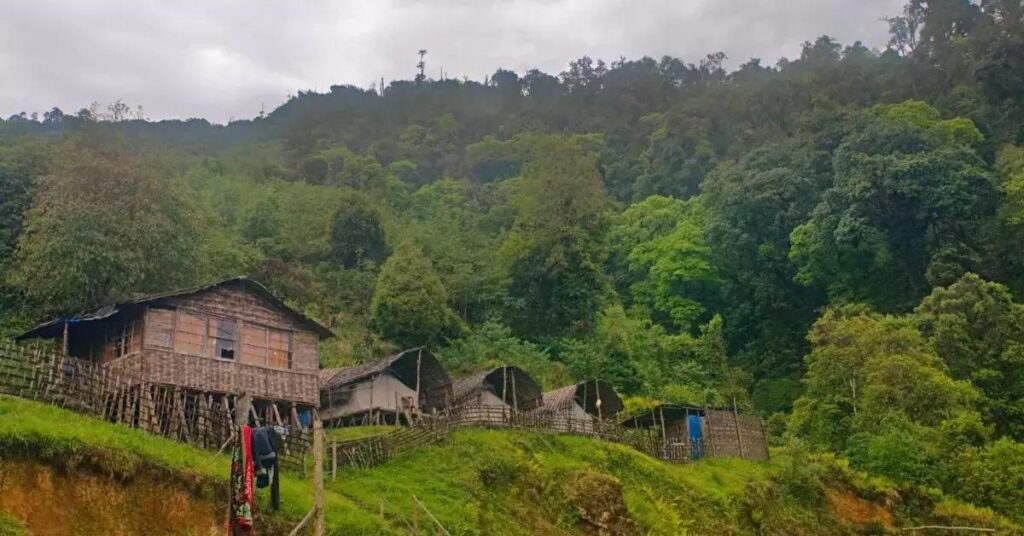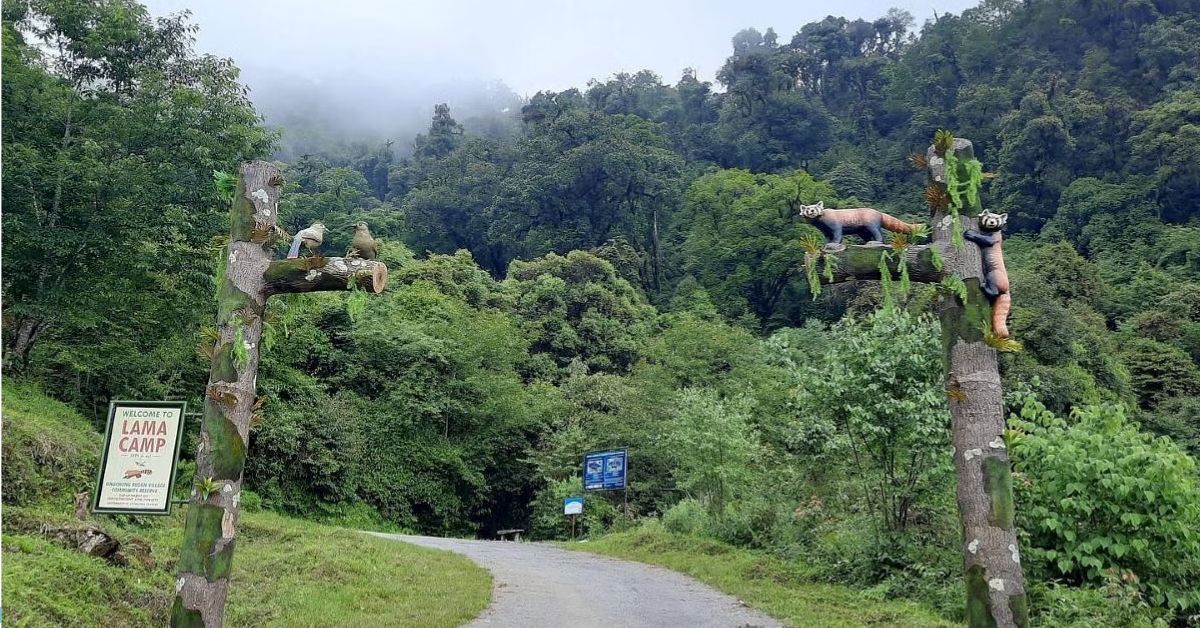Eaglenest Wildlife Sanctuary in Arunachal Pradesh! This 218 square kilometer haven is a dream for nature lovers, bird watchers, and anyone who loves adventure. The scenery here is amazing – mountains, valleys, and fresh air everywhere you look. Plus, there are tons of plants and animals to discover. Keep your eyes peeled for the shy Red Panda or the powerful Bengal Tiger. Bird watchers will have a blast spotting over 450 different feathered friends!
Eaglenest is a special place where you can really connect with nature and get away from the hustle and bustle. It’s a hidden gem in India, waiting to be explored by you!
How to reach:
By Air:
- Closest Airport: Tezpur Airport in Assam is about 150 kilometers away. Flights can be limited here, so consider…
- Alternative Airport: Lokpriya Gopinath Bordoloi International Airport in Guwahati, roughly 350 kilometers distant. From either airport, taxis and buses can take you to the sanctuary.
By Train:
- Nearest Station: Rangapara North Railway Station in Assam sits about 145 kilometers from Eaglenest. This station is well-connected to Guwahati and Kolkata. Taxis and local buses can then connect you to the sanctuary.
By Road:
Eaglenest is accessible by road from major towns in Arunachal Pradesh and Assam. Here are some popular routes:
- Tezpur, Assam: This 150-kilometer journey takes about 5-6 hours by road. Taxis and buses are available from Tezpur.
- Guwahati, Assam: The distance is roughly 350 kilometers, with a travel time of 10-11 hours. Taxis, shared cabs, and state-run buses run from Guwahati to Eaglenest.
Getting Around Once There:
Once you arrive at Eaglenest, local options include private taxis or guided tours organized by local operators. Booking transportation in advance, especially during peak season, is recommended.
best time to visit:
Birdwatching Paradise (October to November): After the monsoon, the landscape explodes with lush greenery. This is prime time for birdwatching as feathered friends flock in for the winter!
Trekking & Clear Views (December to February): Cool and crisp, these winter months are perfect for trekking adventures. Clear skies offer stunning vistas of the Eastern Himalayas – a photographer’s dream!
Blooming Beauty (March to April): Spring paints Eaglenest in vibrant colors with blooming flowers. Wildlife activity picks up, making it a fantastic time to experience the sanctuary’s natural wonders.
attractions:
Diverse Wildlife:

Calling all animal lovers! Eaglenest Wildlife Sanctuary is a must-visit for anyone who gets excited about spotting creatures in the wild. This place is overflowing with life, especially birds – over 450 different kinds to be exact! Birdwatchers will be in heaven searching for the Bugun Liocichla, a super rare bird only found here, or the Himalayan Monal with its stunningly colorful feathers.
But Eaglenest isn’t just a bird show. Keep your eyes peeled for the shy Red Panda, a true prize for any wildlife watcher. Even tigers, clouded leopards, and Asian black bears roam this sanctuary’s thick forests and wild lands. Spotting one of these would be an unforgettable experience! With so many cool animals, all in one place, Eaglenest is a truly special place for nature lovers of all ages.
Trekking and Nature Trails:

Eaglenest Wildlife Sanctuary is a must-visit for anyone who gets a thrill from spotting animals in the wild. This place is teeming with life, especially birds – over 450 different feathered friends to be exact! Birdwatchers will be in paradise searching for the Bugun Liocichla, a super rare bird only found here, or the Himalayan Monal with its dazzlingly colorful feathers. But Eaglenest isn’t just a birding haven. Keep your eyes peeled for the elusive Red Panda, a true trophy for any wildlife enthusiast. Even tigers, clouded leopards, and Asian black bears roam this sanctuary’s dense forests and wild landscapes. Spotting one of these magnificent creatures would be an unforgettable experience! With so many cool animals, all living together in one place, Eaglenest is a truly special place for nature lovers of all ages.
Bugun Village:

Bugun Village offers a unique chance to step into the world of the Bugun tribe. This charming little village is a living museum of their traditions. Imagine wooden houses lining the streets, a tight-knit community, and a chance to see how they live their daily lives.
Bugun Village is more than just a pretty sight. Here, you can meet local artisans who craft beautiful things. You can try delicious food you won’t find anywhere else, and even join in on their celebrations! It’s a chance to experience the rich Bugun culture firsthand, adding a whole new layer to your trip to Eaglenest. This way, you get the best of both worlds: stunning nature and the fascinating culture of the people who call this region home.
local experiences:
Taste the Tradition: Sample delicious Bugun dishes made with fresh, local ingredients using traditional methods. It’s a flavor explosion and a journey into the region’s unique cuisine!
Festival Fun: Witness vibrant Bugun festivals bursting with music, dance, and rituals. Immerse yourself in the local culture and witness their customs come alive.
Village Adventures: Explore Bugun Village on a guided tour. See how they live, from their traditional crafts and farming practices to their daily routines.
Handmade Treasures: Discover beautiful handcrafted items made by local artisans. Find textiles, wooden carvings, and other artistic creations that reflect the region’s skills.
Connect with the Community: Interact with the Bugun people! Participate in community activities, listen to their stories, and gain a deeper understanding of their way of life.
Unique Homes: Explore traditional Bugun houses built with local materials. See their unique architectural style specific to the tribe.
Market Magic: Browse local markets filled with fresh produce, spices, and regional goods. Get a glimpse into everyday life and local commerce.
Nature Walks with a Twist: Join local guides for nature walks who share their knowledge of plants and animals. Learn about traditional uses of local flora for an extra special experience.
Hands-on Learning: Participate in workshops led by local experts. Learn traditional crafts, cooking or other cultural practices, and take home a new skill!
Herbal Secrets: Discover traditional Bugun herbal remedies. Learn about local plants used for medicine and their various purposes.
travel tips:
Permits: Don’t forget to get any special permissions needed to enter the sanctuary. Check with local authorities beforehand.
Travel Insurance: This remote and rugged area is best explored with peace of mind. Get travel insurance that covers adventure activities and medical emergencies.
Weather Watch: Rain or shine, be prepared! Check the forecast before your trip, especially during the monsoon season when landslides can occur.
Dress for Adventure: Pack layers! Temperatures can vary. Bring warm clothes for cool nights and waterproof gear for rain.
Sturdy Shoes: Opt for sturdy, comfortable hiking boots that can handle rough terrain and unpredictable weather.
Cash is King: ATMs might be scarce, so bring enough cash for your stay.
Be Medication Savvy: Pack any medications you need and be aware of altitude sickness if venturing to higher areas within the sanctuary.
Local Guides Know Best: Enhance your experience and ensure safety by hiring experienced local guides for trekking and wildlife spotting.
Respect the Culture: Dress modestly and be mindful of local customs. Always ask permission before taking photos, especially in villages.
Leave No Trace: Be an eco-warrior! Avoid littering and minimize your environmental impact to preserve the sanctuary’s beauty.
Safety First: Wildlife encounters can happen. Be cautious and follow park authority guidelines to avoid danger.
Plan Your Journey: Research transportation from nearby airports or train stations beforehand to ensure a smooth arrival at the sanctuary.
conclusion:
Eaglenest Wildlife Sanctuary shines as a jewel in Arunachal Pradesh’s crown, showcasing the state’s untamed beauty and rich ecological tapestry. This haven for nature enthusiasts boasts a diverse array of wildlife, from the rare Bugun Liocichla to the elusive Red Panda. Rolling hills and dense forests provide a breathtaking backdrop for trekking and nature walks, while the nearby Bugun Village adds a cultural layer with its vibrant traditions. Whether captivated by the sanctuary’s incredible birdlife, enchanted by its serene natural beauty, or intrigued by the local culture, Eaglenest promises an unforgettable and immersive adventure. To ensure a smooth and enriching experience, visit Xplro.com for our comprehensive Eaglenest travel guide. Packed with valuable insights on permits, itinerary planning, and respecting local customs, our guide will help you unlock the magic of Eaglenest and embark on a truly enriching journey that celebrates both the grandeur of nature and Arunachal Pradesh’s rich heritage.
FAQs
What makes Eaglenest Wildlife Sanctuary special?
- Eaglenest Wildlife Sanctuary is celebrated for its exceptional avian diversity, including rare species like the Bugun Liocichla. It also boasts a rich variety of wildlife and stunning landscapes, featuring dense forests and rugged terrain, ideal for nature lovers and adventure enthusiasts.
Where is Eaglenest Wildlife Sanctuary located?
- The Eaglenest Wildlife Sanctuary is situated in the western part of Arunachal Pradesh, India, close to the Bhutanese border, within the Eastern Himalayas. Its remote location offers a pristine environment away from urban developments.
When is the ideal time to visit Eaglenest Wildlife Sanctuary?
- The ideal time to visit Eaglenest Wildlife Sanctuary is from October to April. During these months, the weather is mild and conducive for wildlife sightings. The monsoon period from May to September is less favorable due to heavy rains and challenging travel conditions.
How can I get to Eaglenest Wildlife Sanctuary?
- You can reach the Eaglenest Wildlife Sanctuary by air, train, or road. The closest airport is Tezpur Airport, approximately 150 km away, while Rangapara North Railway Station is about 145 km from the sanctuary. From these points, you can hire a taxi or take a local bus.
Do I need a permit to visit Eaglenest Wildlife Sanctuary?
- Yes, visitors need to secure permits to enter Eaglenest Wildlife Sanctuary. These permits can be obtained from local authorities or travel agencies well in advance of your trip.
What wildlife can I expect to encounter at Eaglenest?
- Eaglenest Wildlife Sanctuary is home to various wildlife species, including the elusive Red Panda, Bengal Tiger, Clouded Leopard, and Asian Black Bear. It is particularly renowned for its bird species, with over 450 documented, such as the Bugun Liocichla and Himalayan Monal.
What should I bring for my visit to Eaglenest?
- Prepare for your visit by packing layered clothing to accommodate fluctuating temperatures, durable hiking boots, and rain gear if traveling during the monsoon. Additionally, bring any necessary medications and sufficient cash, as ATMs may be limited.
Are there places to stay near Eaglenest Wildlife Sanctuary?
- Yes, accommodations are available near the Eaglenest Wildlife Sanctuary, including guesthouses and eco-lodges. It is recommended to book these accommodations in advance, particularly during peak travel seasons.
Can I explore the sanctuary independently, or is a guide necessary?
- While some areas can be explored independently, hiring a local guide is highly recommended. Guides offer valuable knowledge about the wildlife, terrain, and local culture, and help ensure your safety during treks.
What activities can I enjoy at Eaglenest Wildlife Sanctuary?
- Activities in the Eaglenest Wildlife Sanctuary include wildlife viewing, birdwatching, trekking, nature walks, and photography. You can also visit nearby Bugun Village for a cultural experience and to see traditional crafts.
What safety measures should I keep in mind?
- Take precautions by being aware of your surroundings and following park guidelines to avoid wildlife encounters. If trekking at higher elevations, be mindful of altitude sickness symptoms. Stick to designated trails and follow safety instructions from local authorities.
How can I contribute to conservation efforts at Eaglenest?
- Support conservation by practicing eco-friendly behaviors, such as avoiding littering and respecting wildlife and local communities. Consider contributing to conservation initiatives or organizations that work to protect the Eaglenest Wildlife Sanctuary’s environment and wildlife.




